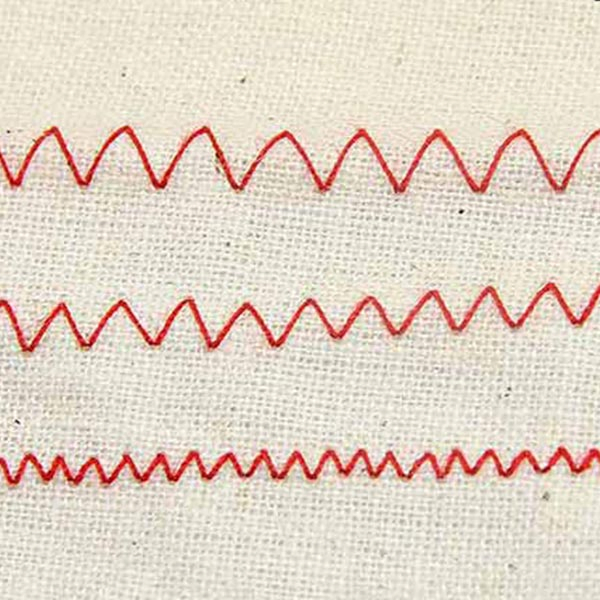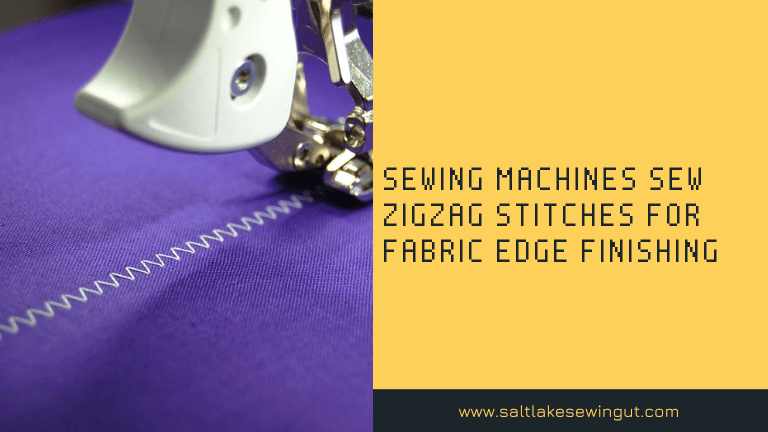Sewing machines have revolutionized the way we create and mend clothing and fabrics. Among the various stitching techniques, zigzag stitches play a crucial role in fabric edge finishing. These stitches are not just aesthetically pleasing but also serve a crucial purpose in fabric edge finishing. In this article, we will explore the fascinating world of sewing machines, uncover the mechanics behind the creation of zigzag stitches, and understand how they contribute to achieving a professional finish for your fabrics.

The Basics of Zigzag Stitching
What Are Sew Zigzag Stitches?
Zigzag stitches are a versatile form of stitching used to secure fabric edges, prevent fraying, and add a decorative touch. Unlike straight stitches, zigzag stitches create a back-and-forth pattern that offers flexibility and strength.
The Sew Sigzag Stitches Mechanism
To understand how sewing machines sew zigzag stitches, we need to look at their mechanisms. Modern sewing machines use a combination of two key elements: the needle and the feed dogs.
1. The Needle
The needle is responsible for piercing the fabric. It moves up and down, creating holes for the thread to pass through.
2. The Feed Dogs
Feed dogs are tiny metal teeth beneath the fabric. They move the fabric forward in synchronization with the needle’s motion.
Creating Zigzag Stitches
Step 1: Thread Selection
Before we dive into the process, it’s essential to choose the right thread. Sew Zigzag Stitches can be created using various thread types, including cotton, polyester, and nylon. The choice depends on the fabric type and your desired finish.
Step 2: Adjusting Stitch Length and Width
Sewing machines come equipped with adjustable settings for stitch length and width. For sew zigzag stitches, you’ll want to increase both width and length. This allows the needle to move laterally, creating the zigzag pattern.
Step 3: Machine Setup
Once you’ve selected the appropriate thread and adjusted the settings, it’s time to set up your sewing machine. Place your fabric under the presser foot and align it with the edge you want to stitch.
Step 4: Stitching Process
Now, let’s break down the stitching process into further detail:
a. Needle Position
The needle starts in a center position, ready to create the zigzag pattern.
b. First Movement
As the machine begins sewing, the needle moves to one side, forming the first part of the zigzag.
c. Second Movement
The needle then shifts to the opposite side, creating the second part of the zigzag.
d. Repeat
This process repeats, creating a continuous zigzag pattern along the fabric’s edge.
Benefits of sewing zigzag stitches
1. Prevents Fraying
Zigzag stitches provide excellent fabric edge reinforcement, preventing fraying and extending the life of your garments.
2. Decorative Touch
Apart from functionality, zigzag stitches can also add a decorative element to your projects, enhancing their visual appeal.
3. Versatility
Zigzag stitching can be used on various fabrics, making it a versatile choice for sewers of all levels.
How do sewing machines sew zigzag stitches for fabric edge finishing?
Types of Sewing Machines for Zigzag Stitches
Mechanical Sewing Machines
Mechanical sewing machines are equipped with a dial or lever that allows users to adjust the stitch width and length manually. These machines are perfect for those who prefer a hands-on approach to sewing.
Computerized Sewing Machines
Computerized sewing machines offer the convenience of pre-programmed zigzag stitch patterns. They provide greater precision and are suitable for intricate sewing projects.
Does zigzag stitch length affect width?
Yes, the length of a zigzag stitch can affect its width, but only to a certain extent, Crafts Stack Exchange suggests that the wider the stitch, the stretchier the result. A zigzag stitch of width 0 (which is actually a straight stitch) will be as stretchy as the sewing thread.
How to set zigzag stitch on the sewing machine?
To set a zigzag stitch on your sewing machine, follow these steps:
Select the zigzag stitch setting: Look for the stitch selector dial on your sewing machine. Turn the dial to select the zigzag stitch setting. The zigzag stitch setting is usually represented by a symbol that looks like a series of diagonal lines.
Adjust the stitch width: Once you have selected the zigzag stitch setting, you will need to adjust the stitch width. The stitch width determines how wide the zigzag stitch will be. You can adjust the stitch width using a dial or lever on your sewing machine.
Adjust the stitch length: The stitch length determines how long each sew zigzag stitch will be. You can adjust the stitch length using a dial or lever on your sewing machine.
Start sewing: Once you have set up your sewing machine for zigzag stitching, you can start sewing your fabric. Make sure to guide your fabric through the machine at a steady pace to ensure even stitching.
Tips for Achieving Perfect Zigzag Stitches
Use the Right Thread
Choosing the right thread for your zigzag stitches is essential. Ensure that it complements the fabric you’re working with and provides the desired level of strength and elasticity.
Practice and Patience
Like any skill, mastering zigzag stitches takes practice. Experiment with different settings and fabrics to develop your proficiency.
Conclusion
In conclusion, sewing machines have made the creation of zigzag stitches for fabric edge finishing accessible and efficient. Whether you are reinforcing seams or giving your project a professional touch, understanding the mechanics and techniques behind zigzag stitching is invaluable. So, go ahead, unleash your creativity, and sew with confidence.
Can I use zigzag stitches on all types of fabric?
Yes, zigzag stitches can be used on most fabrics. However, it’s essential to adjust the stitch width and length to match the fabric’s thickness and stretchiness for optimal results.
Are zigzag stitches stronger than straight stitches?
Zigzag stitches are generally stronger than straight stitches, especially when it comes to preventing seam unraveling and handling stretchy fabrics.
What is the best way to finish the edges of a delicate fabric using zigzag stitches?
When finishing delicate fabrics, use a narrow zigzag stitch with a fine thread to minimize any damage to the material
Can I use a regular sewing machine for zigzag stitching?
Yes, most modern sewing machines, whether mechanical or computerized, come with zigzag stitching capabilities.
How can I troubleshoot issues with my zigzag stitches?
Common issues with zigzag stitches include thread tension problems and needle issues. Refer to your sewing machine’s manual for troubleshooting guidance, or seek assistance from a professional if needed.


3 thoughts on “How do sewing machines sew zigzag stitches for fabric edge finishing?”